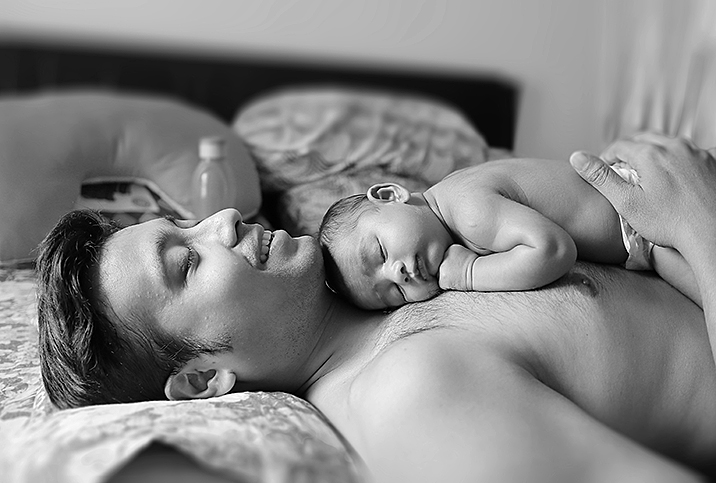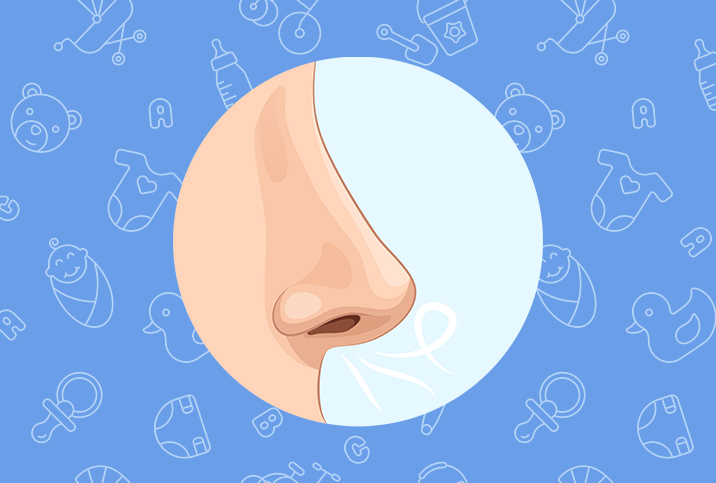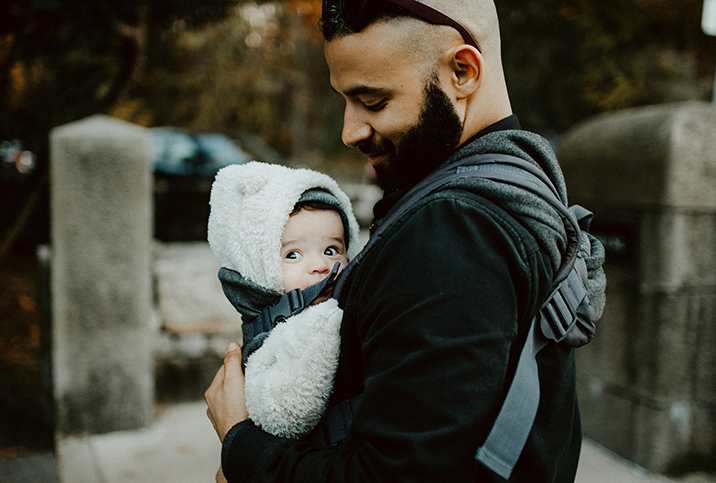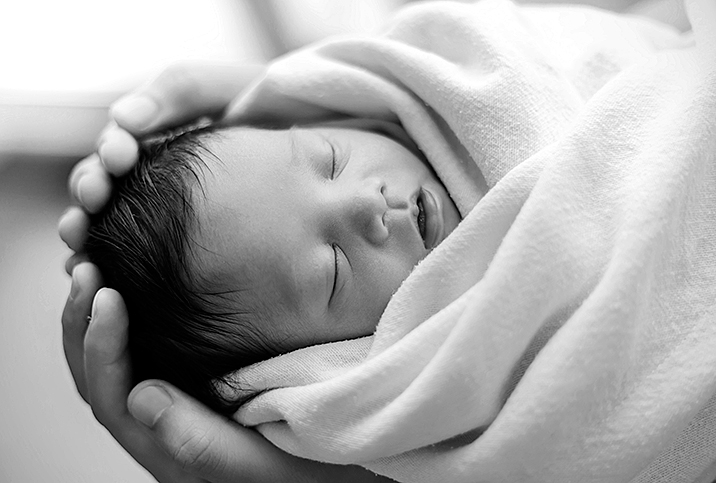Co-Sleeping Safely With Your Baby
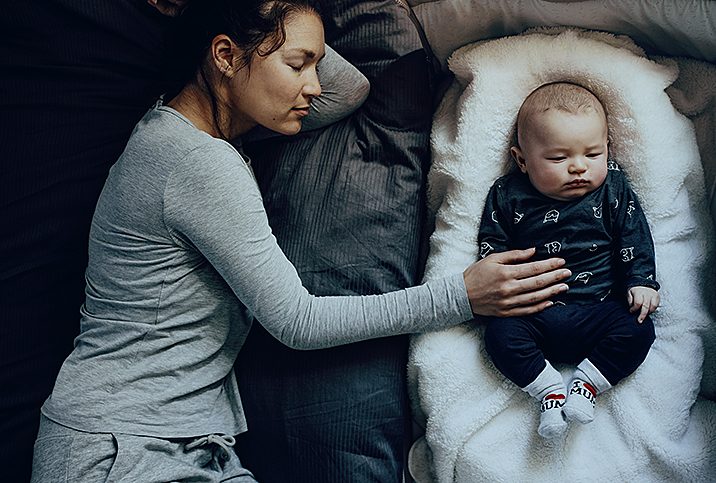
Co-sleeping—specifically, bed-sharing versus room-sharing—was never part of my plan. My brother is an emergency room doctor, and I'd heard about the "safe sleep" guidelines and the increased risk of sudden infant death syndrome (SIDS) in unsafe sleeping environments.
But about three days after my son was born, I was up (yet again) breastfeeding him at 3:00 a.m., bleary-eyed and barely functional. My husband (a Costa Rican with decidedly different cultural views on co-sleeping) said, "Bring him into the bed." So I did.
Of course, I was conscious of the potential risks, so I didn't sleep much (if at all), but even just lying down with him in bed to breastfeed felt more restful than being up and down all night.
This experience flipped a switch, and the next day I started doing more research. I understood the very real concerns about SIDS and the need to create a safe sleep environment. That said, living in Central America, where bed-sharing is much more culturally normalized (I was even expected to bed-share with my infant while I was in the hospital after giving birth), made me question the rationale of the sweeping Western suggestion to avoid this historically, and culturally common, parental choice.
The reality is, there are risks associated with bed-sharing, especially for premature infants or for infants whose parents smoke or use drugs—but they aren't as cut-and-dried as the safe sleep recommendations seem to imply. In fact, there appear to be at least a few protective benefits of co-sleeping (when it's approached wisely) that should weigh into parents' decisions about whether co-sleeping (or bed-sharing) is right for their family.
Official recommendations regarding safe sleep
The American Academy of Pediatrics (AAP) released its most recent Recommendations for a Safe Infant Sleeping Environment in 2016. These recommendations, designed to help reduce the risk of SIDS and other sleep-related infant deaths, provide a list of guidelines for parents to follow to safeguard their infant while sleeping. Specific to the sleep environment, these recommendations include:
- Putting the baby to sleep on their back "for every sleep."
- Using a firm sleeping surface.
- Breastfeeding, which appears to offer protective benefits.
- Room-sharing, with the infant on a separate sleeping surface (their own bassinet, crib or sleep space).
- Avoiding the use of soft bedding or objects in the infant's sleep space.
- Using a pacifier at naptime and bedtime.
- Avoiding smoke exposure during pregnancy and following birth.
- Avoiding alcohol and drug use during and following pregnancy.
- Preventing/avoiding overheating.
Additionally, the AAP emphasizes the importance of prenatal care, vaccinations and the role of doctors, nurses and the media in sharing safe sleep messaging.
Recommendations tend to be conservative to protect those most at risk
Based on these recommendations, bed-sharing with an infant who's sleeping on the same sleep surface as their parents is considered a no-go. The rationale is to help prevent the likelihood of a parent rolling over onto the baby or the baby getting caught in loose or overly soft bedding. Considering how sleep-deprived new parents are, it's easy to imagine how these types of horrific accidents can occur.
One thing to keep in mind, though, is that these guidelines are written with the understanding that the risks involved with SIDS go up substantially with certain, very specific, behaviors. As such, the experts have written more conservative guidelines in an effort to help protect those most at risk.
As pointed out in a 2014 study published in PLOS ONE, parents who drink excessively, smoke or use illicit drugs are much less likely to be able to sleep safely with an infant—as their altered levels of consciousness and impaired ability to wake make accidental deaths more likely.
On the other hand, healthy infants of parents who don't drink, smoke or do drugs are at low risk for SIDS or other sleep-related deaths, even when bed-sharing (although still at a slightly higher risk than those who room-share rather than bed-share).
As the guidelines are written, this difference between high-risk and low-risk scenarios isn't accounted for. And the more conservative guidelines appear to remove some of the flexibility for parents whose infant and family dynamics are low-risk.
This may make a co-sleeping choice feel shameful when, in reality, it's a highly common practice. In fact, according to a 2014 study published in JAMA Pediatrics, rates of bed-sharing in the United States increased between 1993 and 2010, despite sleep guidelines warning against it.
There's evidence that bed-sharing can be protective
When parents actively control for the factors that can make bed-sharing particularly dangerous, the associated risk for SIDS drops substantially. And, when a mother is breastfeeding and bed-sharing with a healthy infant, and doing so in a well-managed sleep environment, the risks are almost negated completely.
Mothers who bed-share with their infants are more likely to breastfeed for longer (it's easier to want to continue breastfeeding if you're not losing as much sleep getting up and down all night), and the known benefits of extended breastfeeding (including reducing the risk of SIDS) are substantial.
Plus, bed-sharing can help mitigate the exhaustion so many new parents feel, as it's easier to wake up, feed and fall back asleep again if you're doing it all from your own bed.
"In certain situations, it's helpful to lie down and nurse your baby to sleep, and co-sleeping safely can foster more parental sleep," stated Leigh Anne O'Connor, a board-certified lactation consultant and the vice president of New York Lactation Consultant Association. When a parent is well-rested, they're more likely to make sound decisions and feel better mentally, which can help make the early transition to parenthood a little easier to manage.
'In other words, unless practiced dangerously, sleeping next to mother is good for infants.'
Finally, from an evolutionary standpoint, there may be additional reasons that families have historically tended to co-sleep (aside from economic or space reasons). For more than 40 years, James J. McKenna, Ph.D., has studied the physiological and psychological well-being and development of infants and mothers who co-sleep and bed-share.
McKenna, who is director of the University of Notre Dame's Mother-Baby Behavioral Sleep Laboratory and the leading authority on mother-infant co-sleeping, explained the apparent biological draw that mothers and their babies have for sleeping side-by-side in a 2008 essay for Neuroanthropology:
"Irrepressible (ancient) neurologically based infant responses to maternal smells, movements, and touch altogether reduce infant crying while positively regulating infant breathing, body temperature, absorption of calories, stress hormone levels, immune status, and oxygenation," McKenna wrote. "In short, co-sleeping, whether on the same surface or not, facilitates positive clinical changes, including more infant sleep, and seems to make babies happy."
"In other words," McKenna concluded, "unless practiced dangerously, sleeping next to mother is good for infants."
Don't bed-share without careful consideration
In Western cultures, based on the safe-sleep guidelines, many parents feel like they shouldn't bed-share. But research indicates that many parents do, in fact, bed-share at least occasionally. In 2015, the Centers for Disease Control and Prevention (CDC) reported that at least 61 percent of parents occasionally bed-share. This doesn't mean bed-sharing takes place all the time, or even intentionally. For instance, even if a baby has their own bassinet to sleep in, many parents might bed-share during naps, or for the last few hours of the night after getting up for the final nighttime feeding.
Given that this is the case, it may actually be safer to bed-share intentionally, rather than doing so "accidentally" when an exhausted parent makes a one-off decision to collapse into the bed with the child. This allows for parents to make sure the sleep surface, bedding and location of the child is all-around safer and prepared for. And it ensures that both parents are aware of the child's presence in the bed (not simply one parent bringing the child into the bed in the middle of the night when the other parent is sleeping), which may also reduce the likelihood of a terrible accident from taking place.
Specifically, if bed-sharing is something you're considering, even just for a quick nap here or there, you need to make sure you're following bed-sharing guidelines that help reduce the risk of SIDS. You also need to make sure your partner is aware of the occasional (or regular) bed-share: All caregiving adults need to be in support of this method of sleeping and should never be sharing a sleep surface with an infant unaware of its presence.
Bed-sharing guidelines to reduce the risk of sleep-related death
McKenna has recommended the following guidelines for safer bed-sharing.
- Bottle-fed babies should sleep alongside the mother, but on a separate surface, rather than in the bed.
- Both parents (if both parents are sharing the bed) should agree to the bed-sharing arrangement and agree that they're both equally responsible for and aware of the infant in the bed.
- Infants should not share a bed space with other siblings (or pets).
- Parents who have an altered state of consciousness (under the influence of sedatives, medications or drugs, alcohol, or other substances)—those "unable to arouse easily from sleep"—should not co-sleep on the same surface as the infant.
- Mothers with long hair should tie up their hair to prevent infant entanglement.
- Extremely obese individuals or anyone who may have "difficulty feeling where exactly or how close their infant is in relation to their own body" may want to have the infant sleep alongside, but on a separate surface (like a co-sleeper attachment), than the parent.
La Leche League International also put together a nursery rhyme (sung to the tune of "Row, Row, Row Your Boat") to help parents remember the "Safe Sleep 7" for safer bed-sharing:
No smoke, sober mom
Baby at your breast
Healthy baby on his back
Keep him lightly dressed
Not too soft a bed
Watch the cords and gaps
Keep the covers off his head
For your nights and naps.
It's a personal decision based on knowledge and awareness
At the end of the day (literally and figuratively), it's every parent's right to make sleep choices that work best for them and their children. Parents who choose to co-sleep or bed-share shouldn't feel guilty or ashamed for their decision to do so, and they can feel good that there's solid research to support some of the benefits of this type of sleeping arrangement.
"Bed-sharing has existed as long as humans have been on earth," O'Connor said. "It's the biological normal way for babies to sleep."
That said, bed-sleeping does carry risks, and these risks should be thoughtfully considered and carefully managed. And, it's important to remember that parents should talk to their pediatricians about their infant's risk level and desired sleeping arrangements. Doctors can help parents determine whether there are additional steps they can take to help prevent a sleeping-related death based on their child's and family's individual risk factors.












